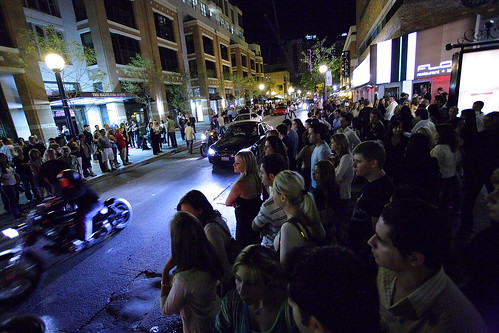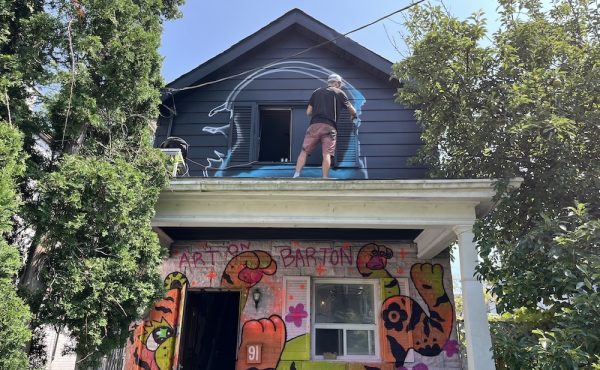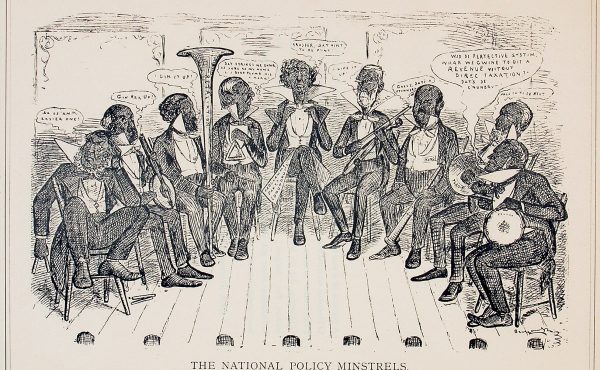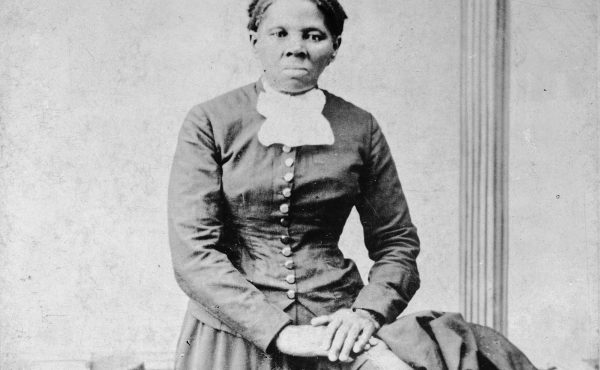

Every Thursday, Spacing will bring you a snapshot of Toronto’s past, looking into what took place that day in the city’s history. Throwback Thursday will address how the city has evolved, with an emphasis on issues that remain relevant for development in Toronto today.
– – – – – – – – – – – – – – – – –
It was thirty-one years ago today that The Riverboat, Canada’s most famous coffee house of the time, closed its doors. Although it shut down in 1978, The Riverboat was in its prime a decade earlier, when Yorkville was the “music mecca of Canada” and the launching point for many international careers in the arts.
Although the Riverboat is the best remembered Yorkville music venue — providing one of the first stages for a long list of young Canadian musicians like Gordon Lightfoot, Joni Mitchell, Neil Young and Murray McLauchlan and the site of a heritage plaque unveiling last week — there were over 40 clubs, coffee houses, and galleries in Yorkville featuring live music in the late 1960s.
At 88 Yorkville Avenue there was the Chez Monique where the Sparrows (later known as Steppenwolf) regularly played. Ian & Sylvia were known to perform at the nearby Village Corner and the little known band that went by the name of The Mynah Birds and featured both Neil Young and Rick James together actually took their name from the Mynah Bird coffee house at 114 Yorkville Avenue. Not to mention the Penny Farthing, known for its swimming pool and bikini-wearing waitresses, the New Gate of Cleve, the Café El Patio and the Flick, Yorkville was a regular musical hotbed filled to the brim with budding artists.

In many ways, Yorkville in the 60s was the Canadian counterpart to Greenwich Village and Haight-Ashbury. With Margaret Atwood doing readings at the Bohemian Embassy, the Grab Bag convenience store open late into the night selling rolling papers, hookah pipes and munchies and numerous rooming houses populating the district, Yorkville became a tourist destination for people itching to witness or take part in 60s bohemian culture.
The area’s fame, however, was a mixed blessing for Yorkville. As the influx of spectacle-seeking tourists increased, so too did bumper-to-bumper traffic on the narrow one-way streets. The escalating congestion prompted local citizens to begin what some current City councillors and journalists might have called the city’s first “war on the car.” Although overshadowed by the Spadina Expressway fight that happened only a few years later, in the late 60s the young adults and residents of Yorkville began fighting to ban cars on Yorkville Avenue to improve air quality and pedestrian safety.
A local group of arts promoters and social service providers known as the Diggers took up the cause of making Yorkville Avenue car-free at night, first organizing a ‘love-in’ at Queen’s Park on May 22, 1967 for over 4,200 people, followed by a three day ‘sit-in’ on Yorkville Avenue that led to clashes with the police and 61 arrests. The Diggers followed the ‘sit-ins’ with ‘sleep-ins’ at Nathan Phillips Square in the hopes of pressuring Mayor William Dennison to listen to the Yorkville villagers’ demands.
Facing huge political opposition, even the support of the Yorkville businesses wasn’t enough to sway an obstinate City Hall, which thought of Yorkville’s hippie culture as a “sore on the city.” Instead, City council decided to step up its police presence, so in the fall of 1967, a paddy wagon was parked at the corner of Hazleton and Yorkville on the weekends and a 10pm curfew was enforced for under-18s by a police foot patrol. The summer of love marked the turning point in Yorkville’s history where it transitioned from an incubator for Canadian music and arts to a ritzy destination catering largely to the rich and famous.
The following summer, vagabond motorcyclists arrived to sell heavy drugs in the area and began acting as Yorkville’s unofficial police force, known to locals as ‘The Vags.’ A supposed hepatitis epidemic broke out in Yorkville in August 1968 known as ‘Hippie Hepatitis,’ which gained huge press coverage and led to vaccine stations being set up along the Yorkville sidewalks. This caused a mass exodus of Yorkville villagers to flee to the country and other areas of the city, despite relatively few people actually becoming infected.
Land speculators also facilitated the transformation of Yorkville by letting properties decay so that they could be bought cheaply. The principle developer behind this was Richard Wookey, who had been buying buildings in the neighbourhood since the mid 1960s. It was Wookey that eventually built Hazelton Lanes after buying seventy houses in the neighbourhood. Wookey also arranged the land deal that built the 32-floor Four Seasons Hotel at Avenue and Yorkville.
Today, Yorkville is the third most expensive retail space in North America, with the stretch of Bloor Street from Avenue Road to Yonge Street recognized as the seventh most expensive shopping street in the world. Along with the 1993 addition of the $3 million Village of Yorkville Park that includes a chunk of the Canadian shield, Yorkville is now better known for celebrity spottings at Sassa Fraz, TIFF receptions and conspicuous consumption rather than for a budding indie music scene or experimental arts community.
Although no longer in Yorkville, the last decade in Toronto has seen a similarly vibrant music scene develop in other areas of town. Spacing editor Ed Keenan’s “Making a scene” charts the many Toronto musicians and bands now making a name for themselves and their city much like the revered musicians of Yorkville once did four decades ago.
For a more complete look at the Yorkville music scene of the 60s, see Nick Jennings’ book After the Gold Rush, Stuard Henderson’s Making the Scene, CBC documentary broadcasted in September, 1967 called Yorkville: Hippie Haven and the National Film Board documentary Flowers on a One Way Street
Photos and Video from the Toronto Star File Photos, Toronto Archives (Series 374, File 1103, Item 7) and JP1958






9 comments
what a great article! I’ve heard so much nostalgia for Yorkville from middle-aged Torontonians, this helps me get it.
All those high-principled hippies sold out and became the BMW-driving Bay Street bankers selling fancy financial products like subprime mortgage asset-backed securities of today.
Interestingly the traffic congestion on Yorkville was mainly gawkers from around town who came to see the hippie culture, like they were driving through the African Lion Safari.
The last decade? Toronto had a great music scene in the late 80s and early 90s. Probably before that too, but I was underage so I wouldn’t know.
I performed at the Café El Patio and the Flick, with the rock band Manna. If anyone has photos I would love to see them Thanks
Bruce,
Interesting – I also performed at the El Patio in a band called the Evils. I recall that Sal Mineo and the Sparrows were in the audience. I dropped out and went to college in the states – never did get to be one of the BMW driving bay street bankers, though…
I frequented the area between 1967-70 and will always remember it fondly. Spent many pleasant hours sipping cappuccino and mocha while playing chess at the Penny Farthing. Lots of draught beer at the nearby Embassy Tavern or the Place Pigalle on Avenue Rd. Saw many performers at the Riverboat incl. Lightfoot, Mitchell and James Cotton among others. It was great until the bikers, Rochdale crazies and the developers arrived on the scene. Now rapidly fading into a distant past, but I for one will never forget it.
Before that, it was the old Gerrard St. “Village”. Anybody remember that scene?
Mike Cline I would really like to hear from you I’m now good friends with Bobbi Lee he was the house band at the Myna Bird. You can find me on facebook or myspace. Just google Bruce Palait.
I miss “Smokers Paradise”, Used to hang out there smoking “Beedies” and reading “Underground comics” like “Zap Comics” with “Mr. Natural” and “Fritz The Cat”
Those were the days, Just like “Rochdale”, The 60 and 70’s died when Yorkville died.
I have been nostalgia tripping lately and the Star recently listed some Toronto clubs closing like Larry’s Hideaway, Gasworks and The Edge and many other. In this Yorkville piece, the Embassy is mentioned but not the Palm Lounge Room in the basement. The room had tacky plastic palms along each side. I saw Roy Orbison and had front row seats. There were so few of us there.